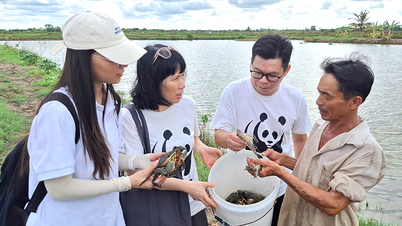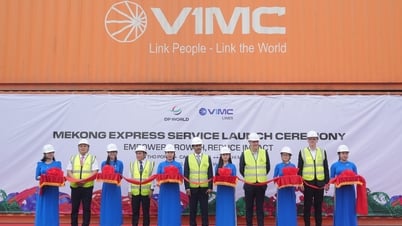Raising mud-free eels in composite tanks has the advantage of being more convenient to move and clean, and the eels will not get scratched.
At the end of 2019, while staying at home due to the Covid-19 pandemic, Mr. Pham Ngoc Dung (born in 1993) in Nam Binh village, Thach Dai commune (Thach Ha district, Ha Tinh province) wondered how to earn income for his family. In his free time, he went online to learn about economic models and found that eels are an aquatic species with high nutritional value, are very popular in the market and can be raised in many forms such as in cement tanks, composite tanks or in tarpaulin-lined tanks. In particular, eels can be raised in small areas and on a small scale.
Taking advantage of the vacant land around the house and available materials, Mr. Dung made 5 tanks, lined them with tarpaulin, each tank has an area of 5 square meters to raise commercial eels using the mud-free farming method.

Every day, Mr. Dung only has to spend a few hours feeding the eels and changing the water. Photo: Anh Nguyet.
He ordered 10,000 eels from Phu Yen province to raise (500 eels/kg). After 8-10 months of raising eels to 4-5 eels/kg, he started selling them. In the first batch, he collected more than 1.5 tons of eels, bringing in a revenue of more than 200 million VND, after deducting expenses, he made a profit of more than 60 million VND.
Initially, seeing that raising eels without mud brought him a good income, he continued to research techniques and learn from successful eel farmers. In the following years, each year he harvested over 2.5 tons of eels from 5 tarpaulin-lined tanks, raising his total revenue to nearly 300 million VND. After deducting expenses, he made a profit of over 100 million VND. To limit the production of too many products at the same time, causing prices to drop, Mr. Dung chose to raise eels, with the tanks not harvested at the same time but usually 2 months apart.
According to Mr. Dung, for eels to grow and develop well, first of all, when making a breeding tank, it is necessary to ensure that the tank is airy. Eels are quite sensitive to the water environment in the tank, so the water must be changed daily after feeding; on the water surface, it is necessary to spread a lot of nylon fibers as a substrate for the eels to live. In addition to feeding the eels with industrial bran, Mr. Dung also feeds them with earthworms, minced fish, and chicken eggs, which not only helps reduce the amount of bran but also provides the best nutrients to help the eels stay healthy and grow quickly. In addition, he also focuses on preventing and treating common diseases in eels such as intestinal bleeding, fungus, etc.

Mr. Dung's current mud-free eel farming system. Photo: Anh Nguyet.
The advantages of raising eels without mud are less care, less space, favorable output and always stable prices at a high level. On the other hand, raising eels without mud helps eels to be less susceptible to disease because they do not come into contact with bacteria in the muddy environment. Every day, it only takes a few hours to feed the eels and change the water, ensuring that the water is always clean and clear, so that the eels will be healthy and less susceptible to disease.
To ensure a safe water source for raising eels and help them grow healthily, Mr. Dung has built a systematic water discharge system. He puts all the eel wastewater into a settling tank, which is used to raise catfish and duckweed. He also uses probiotics to treat waste and leftover food from eels, keeping the water clean and reducing environmental pollution.
Realizing the potential of the consumer market, in early 2023, Mr. Dung invested more than 1.5 billion VND to buy 45 composite tanks, farming tools, food and eel breeds. Currently, he owns more than 120,000 eels on the farm. "I am implementing farming at a density of 500 fish/m2, so I have to change the water more, 3-4 times a day to ensure an environment for the eels to grow healthily," Mr. Dung shared. According to Mr. Dung, each person chooses a different way of raising eels. He himself chose composite tanks because they are more convenient for moving, cleaning and the eels do not get scratched...

Raising mud-free eels in easy-to-clean composite tanks prevents eels from getting scratched and helps them grow well.
Mr. Duong Van Hai, Vice Chairman of the People's Committee of Thach Dai Commune, Thach Ha District, said: Mr. Pham Ngoc Dung's mud-free eel farming model is a typical economic model of the locality. Overcoming difficulties, the model has demonstrated the new thinking and working methods of young people to get rich on their homeland. The local government is researching and proposing to all levels to support policies for eel farming households, at the same time organizing propaganda, technical training, and mobilizing people to replicate the model...
Huong Hoai (according to nongnghiep.vn)
Source



![[Photo] National Conference "100 years of Vietnamese Revolutionary Press accompanying the glorious cause of the Party and the nation"](https://vphoto.vietnam.vn/thumb/1200x675/vietnam/resource/IMAGE/2025/5/30/1cf6cd5c8a934ebfa347028dcb08358c)
![[Photo] General Secretary To Lam receives Chief of the Central Office of the Lao People's Revolutionary Party](https://vphoto.vietnam.vn/thumb/1200x675/vietnam/resource/IMAGE/2025/5/30/140435f4b39d4599a3d17975dfb444c5)
![[Photo] Journalists moved to tears at the Memorial Service for the soldiers who died in Gac Ma](https://vphoto.vietnam.vn/thumb/1200x675/vietnam/resource/IMAGE/2025/5/30/9454613a55c54c16bf8c0efa51883456)

![[Photo] A delegation of 100 journalists from the Vietnam Journalists Association visits the soldiers and people of Truong Sa island district.](https://vphoto.vietnam.vn/thumb/1200x675/vietnam/resource/IMAGE/2025/5/30/0984a986227d4e988177f560d2e1563e)
















































































Comment (0)